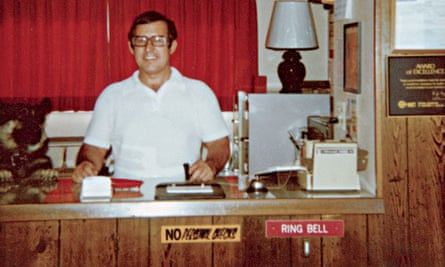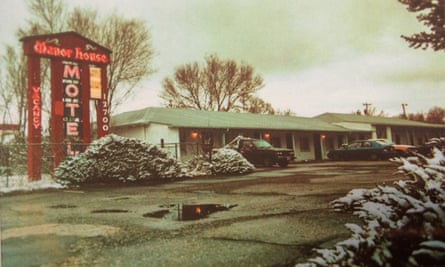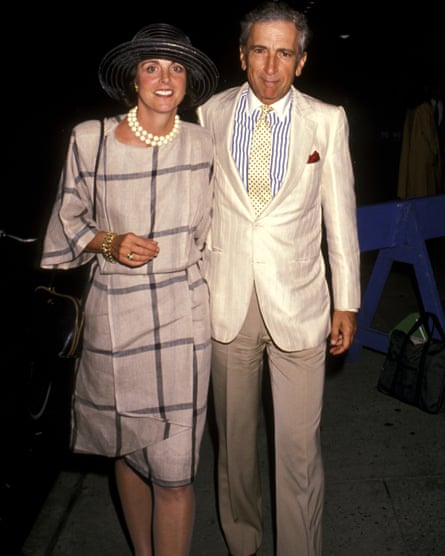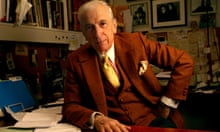In January 1980 the celebrated American journalist Gay Talese received a handwritten letter from a man named Gerald Foos, the owner of a cheap roadside motel outside Denver, Colorado. Talese had, at the time, become infamous in the New York literary world and beyond for spending nearly a decade in the massage parlours and free-love communes of 1970s America – as both thoughtful observer and enthusiastic participant – in order to write his bestselling book Thy Neighbor’s Wife, billed as the inside story of the nation’s sexual revolution. Gerald Foos contacted Talese in 1980 because he believed he was a chapter that the writer might like to add to that book.
Intrigued, Talese went to visit the motel owner. When they met at Denver airport, Foos first made Talese sign a confidentiality agreement, and then revealed exactly how, at the same time that Talese had been doing his research into America’s new sexual freedoms, he had been conducting a rigorous inquiry of his own. Foos had converted his motel into a voyeur’s paradise, creating elaborate grilles in the ceilings of several rooms through which, most nights for the previous decade, he had spied on the occupants’ activities, masturbating and taking careful notes. Sometimes he watched with his wife. Foos invited Talese into the motel attic, and for three nights on hands and knees the writer observed the voyeur observing the intimacies of his guests.
Talese was then faced with a question: should he break the signed agreement and expose Foos? Looking back he felt obliged, he claims, to honour the terms of their agreed confidentiality. Foos wanted Talese to write his story as fiction, or to at least change the names. He refused. Over subsequent years Foos sent Talese extracts from a memoir he was writing based on the extensive journal he had kept from his “observation platform”, which detailed everything he had seen, including, apparently, the murder of a woman by her boyfriend that he had witnessed in 1977 and never reported for fear of exposure. Talese still said nothing. And then, in 2013, after a silence, Foos, long retired from the motel business, contacted Talese again; now nearly 80, he had decided that he wanted his story told in full. Talese took time off from a book he was writing about his 55 years of marriage, and went to visit Foos in Denver once more.
The result of all that is a book by Talese, The Voyeur’s Motel, due out next week, trailing controversy. When the New Yorker magazine published a long extract from it in the first week of April this year it created a minor sensation and a degree of incredulity. Many people questioned Talese’s moral judgement in not exposing Foos before. The New Yorker’s editor, David Remnick, defended the article, writing that “the New Yorker does not believe that Talese or it violated any legal or ethical boundaries in presenting Foos’s account.” Steven Spielberg’s DreamWorks acquired the film rights to the story of Foos; Sam Mendes became attached to the project as its director.

The controversy deepened ten days ago when a Washington Post reporter confronted Talese with some factual discrepancies he had discovered in Foos’s account in the book; most notably that for much of the time that the motel owner claimed to be continuing his “research” in the 1980s, after Talese’s visit, he was no longer the motel’s owner. Hearing these accusations by phone, Talese’s immediate response was to say that his book’s credibility was now “down the toilet”; on more considered reflection, a day later, he retracted that comment to say that he stood by what he had written – the bulk of which was not in any way disputed by the Washington Post’s investigation – and that he had always made it clear that Foos was not entirely an accurate or reliable witness.
A week before the Washington Post made those allegations, I met Talese at his home in New York. He is a tall, elegant man, 84 years old, sharp-eyed and in robust health. He lives in considerable style, with his wife Nan Talese, long the doyenne of American book publishing, in a three-storey townhouse just a couple of doors away from Park Avenue on Manhattan’s Upper East Side. He bought a flat in the house as a journalist on the New York Times in 1957, and the rest of it with the proceeds of film rights to Thy Neighbor’s Wife (sold for a then record $2.7m, though the film was never made).
Talese is the son of an Italian tailor. He comes to the door in a pale grey suit with waistcoat and orange tie, and settles in a sofa facing me, affably, in his book-lined sitting room. His sentences are as well cut as his clothes. He talks in rounded paragraphs, and with some nostalgia for the days when he pioneered the revolutionary form of “new journalism” in the 1960s, which applied the techniques and voice of the great American short story to nonfiction subjects, immersing the writer fully in the tale. Talese, alongside Tom Wolfe, Truman Capote and others, was considered the master of that form, inhabiting his subjects’ interior lives – mafia dons, sports stars, New York eccentrics – with irresistible persuasion; 50 years on, his story “Frank Sinatra Has a Cold” remains the acknowledged high-water mark of magazine profile writing. At one point in our conversation I ask him whether, during his legendary research process, months and years perfecting the “art of hanging out”, he ever went native, ever forgot he was a reporter. “Never once,” he says firmly. “For Thy Neighbor’s Wife, for example, if a woman was performing oral sex on me I was looking around the room making sure I had the colour of the wallpaper right. I always had that dual perspective. Accuracy was extremely important to me.”
It is sometimes said that writers are drawn to certain subjects in order to understand themselves a little better; that all journalism is a form of autobiography. Talese does not concur with that idea necessarily, but he does concede that Foos, the motel voyeur, was the “perfect Gay Talese character”.
How so?
“Perverted? Maybe. Interesting? Yes. Disgusting? Uh-huh. But what he saw was really worth reporting.”

The Voyeur’s Motel quotes extensively from Foos’s compulsive observations, but Talese is at pains to present his memoir as much as a work of sociology as one of prurience. Foos was fascinated by the patterns of behaviour he saw, as well as the sex: “Wives who cheat on their husbands and vice versa. Lesbianism, of which I made a particular study… Homosexuality, of which I had little interest, but still watched to determine motivation and procedure…” He was perpetually intrigued by the gap between public and private lives: “The majority of vacationers,” he wrote, “spend their time in misery. They fight about money; where to visit… You can never really determine during their appearances in public that their private life is full of hell and unhappiness…”
Talese sees Foos’s invasive perversion as a unique window on America at a particular moment in time, dwelling on the poignancy of him watching wounded Vietnam soldiers meeting their girlfriends and wives, or seeing “blacks and whites having sex before it became a trend”. For Foos, arousal often competed with despair and sadness at what he witnessed. He began to conduct bleak experiments with his unwitting subjects. He would leave pornographic magazines in the bedside table, note how people complained to him at the front desk about it, “but only after he had watched them jerk off”. He left padlocked suitcases in the rooms and observed vicars and prim couples jemmy them open. And he detailed the cold exchanges that passed for marital passion, noting that it often appeared that “only lesbians seem to enjoy pleasing each other”.
“The voyeur fancied himself as a scientist,” Talese says. “He thought: why should [the social psychologists] Masters and Johnson or Kinsey take credit for their studies of human sexuality, when they were all staged?”
One of the curiosities of the book is that having gone to such lengths – triple-layer carpets, secret doors – to avoid detection, Foos decided late in life to reveal himself. What does Talese believe prompted that?
He suggests that Foos, widowed and then married for a second time, was very lonely. That at least when he was sneaking around in the attic he had some one-sided sexual relationships. “A really dedicated voyeur has no daily life,” Talese says. “Foos has an arthritic condition that means he can’t get out much. It is all over for him.”
When Talese went to see Foos again in Denver in 2013, he barely recognised him. He made three more trips between 2013 and 2015 trying to fill in gaps in the story, visiting the scenes of Foos’s adolescence that had prompted his adult obsession – the window through which he used to spy on an undressing aunt. On the last visit he took an independent film crew with him, and they stayed in the original motel and photographed the patched-over vents in the ceiling, prior to the building being demolished last year. I wonder, since the New Yorker extract led to him being identified in the local press, if Foos is now regretting his decision to tell his secret?
“He wanted to move house,” Talese says. “I told him not to. I said the [Denver] Post would find out and the new neighbours would probably protest as if you were a rapist. When the book comes out I’ve told the publicist: I don’t want this guy on television, some Jesus freak will blow him up.” In the event, when the New Yorker piece came out some people threw eggs at Foos’s house, but so far that has been it.

Does Talese have any qualms about signing and abiding by that original confidentiality agreement?
“We quarrelled about it for many years,” he says. “I told him it has to be verifiable. I said I’m not going to make up stuff, or be cruel, but you are a voyeur. ‘Yes,’ he said, ‘I’m the world’s greatest voyeur!’ That meant something to him.”
Often in the book Talese questions his own motivations: how complicit is he in this behaviour? These questions became particularly pointed when he received Foos’s account of the murder he claims to have witnessed, a drug dealer attacking his girlfriend, who was found dead in the morning. Talese confronted Foos about it straight away on the phone, but he did not contact the police. Why not?
“It never really occurred to me, to be honest,” he says. “It had happened in 1977. I met this guy in 1980, and I learned about the murder some years after that. When I went to Denver for the book, then I approached the cops. They had no record. I went to every place they have records. The coroner of both counties, Denver Post. There is no record of it happening.”
It seems hard not to conclude, reading the book, that Foos simply made that episode up. Though he allows the possibility, Talese does not seem to want to entertain the idea – presumably because it calls much else into question. Was he really convinced Foos was on the level about it?
“I am. Why would he make it up? He certainly doesn’t need to complicate his life any further with a possible lawsuit of criminal negligence or something. He didn’t want to be involved. That’s what the voyeur does.”
As Talese notes in this book, and as he examines more forensically in the final chapter of Thy Neighbor’s Wife, there is a close kinship between journalism, particularly the kind of journalism he does, and voyeurism. Was he attracted to the story in part because it was a neat metaphor of the reporter’s life?
“Well,” he says, “most journalists are voyeurs. Of course they are.”
And I guess most readers, most people, are vicarious voyeurs too.
“Yes. Unless you are so self-centred, like these people walking around with their noses in phones all day. I’ve never had a cellphone. I have tried to always be looking up and wondering.”
Talese believes, like Foos, that his own habits of curiosity about the intimate lives of others were ingrained early. Talese grew up in Ocean City, in Maryland, during the war. His mother had a dress shop next door to his father’s tailor’s. They lived above it. He grew up eavesdropping. “I would work at the store watching my mother take these women into the fitting rooms to help them on with dresses,” he says. “I’d see women in brassieres, telling her about their lives. That was my journalism school. I learned to treat people with respect, I learned when not to ask questions, how to make people feel at ease. These were not women who would get their names in the papers, but they had stories to tell.”
When he moved to New York and began to work as a reporter, Talese went in search of comparable stories from “doormen and charwomen and waiters”. He had a fascination with untold lives, closed doors. He spent six years researching a book about the Italian New York mafia, Honor Thy Father. And he followed that, naturally as he suggests, with his quest into the hidden world of sex.
When he was up in the attic with the voyeur, did it feel like a normal day in the office?
“Well,” he says, “much of it was boring. You are sat for hours watching people watch television. And even the sex seemed quite routine. I was so jaded by then. I’d had five years being a sort of resident of orgyland.”
Reading Talese’s Thy Neighbor’s Wife now is to enter another country, one of suburban obsession with permissiveness. The book was published just before Aids effectively closed down that national experiment. Does it feel like a period piece to him, looking back?
In a way, he suggests. “But it began like any other assignment, with that curiosity about other people’s lives.”
In the course of his research Talese found himself at one point managing a New York massage parlour…
“Yes. But before that I was a customer. I was interested in finding a woman to tell me what it was like to work day and night there. I found the world of mercenary sexuality so fascinating, I started to volunteer to work in these places for nothing; one of them was a block away from the publishing company where my wife worked. I was essentially an unpaid pimp. I had the masseuses take notes for me.”
Talese writes elsewhere about his quite repressed upbringing. “I had a Catholic education which meant every Sunday the priest would warn you off dirty books and filthy movies,” he says. Until he was 22 he claims to have slept on his back with his hands crossed over his chest to avoid self-abuse. Thy Neighbor’s Wife culminates with him, aged 50, living at a nude commune called Sandstone on the cliffs above Malibu in LA.
“You were out there in the daylight on the lawn and everyone has their clothes off, 200 people on a Saturday afternoon,” he says. “And in the evening you could have sex with any one of them in the ballroom.”
Talese lived at Sandstone for six months. Once you got used to the nudity, he says, it was “the most natural tranquillising feeling. So at peace, so unaroused. I had a little room, got to know everybody, got the history of that place. I was interviewing but I was also participating. There was no press box. So when I got to the voyeur, what was there left for me to see?”
But surely there was a big difference between that consenting environment and the motel attic?
“There was,” he says. “But what this guy John Williamson [who owned Sandstone] was trying to say, was that sex doesn’t mean that much. It’s a really nice introduction to someone, but you get over that in about an hour. You could be happily married and have sex with another couple. That was the idea.”
His wife, Nan, doesn’t seem to have been convinced of that theory – she didn’t join him?
“No. So I took substitutes because you had to be with a woman. There was group sex, five or six people. A couple of times the great Dr Alex Comfort and me and his wife and a couple of others would have group sex. Comfort’s book, The Joy of Sex, sold all over the world. I thought that sonofabitch just learned what he learned in that ballroom. We both had books out of it.”
How did Talese’s marriage survive?
“I was sort of separated for a bit,” he says. “I believe that both Nan and I had such a strong marriage that it was possible.”
And she was prepared to indulge his experiments?
“I think so. If we didn’t have children it would have been fine. As it was I had two not-quite teenage girls, and that did cause complications. I mean people would talk about me, ‘the so-called writer who was working in the sex industry’. I didn’t have a way of communicating to my girls.”
Does he think that had a lasting effect on them?
“I worry about that,” he says. “I’m 84 and my daughters are 51 and 48 and they are both divorced and never wanted children; they are very beautiful like their mother. And I still think all the time: did it have something to do with the book. Did it? I have no idea. I have not interviewed them on the subject because I don’t think they understand either.”

Thy Neighbor’s Wife sold in huge numbers but was not a great critical success. After it, Talese pursued different stories. He lived on and off in Italy for some years, unearthing the lives of his father’s family in Calabria, which became a book: Unto the Sons. He subsequently wrote a curious memoir, A Writer’s Life, mostly about the frustrations of researching stories that were never published, an experience familiar to him after he joined the staff of Tina Brown’s New Yorker. He had always been drawn to failure – but now he experienced it for himself. He worked for years on tales about a restaurant site that always went bankrupt, a Chinese woman footballer who missed a World Cup penalty, the emasculation of John Wayne Bobbitt. None of the stories were published.
“I have often been frustrated,” he says. “All writers are. That restaurant story was so hard. I was travelling all over trying to find some damn sous chef. And then nobody wanted it. And the story of the guy who lost his penis. I still get Christmas cards from both him and his wife.”
Having read A Writer’s Life, it is tempting to imagine that, aged 81, Talese might have been more than usually anxious to have one last sensational story to tell, a return to the glory days. In this sense the phone call from Gerald Foos must have seemed like a proper gift from real life, almost too good to be true.
When the Washington Post story came out, I tried to reach Talese by phone for his feelings about the doubts that had been raised about the veracity of parts of Foos’s account. At his request, instead I sent some questions by email. He acknowledged that, given his pathological need for accuracy, he had been “deeply upset” by the allegations, and had called Foos to have him explain in person to the Washington Post reporter the discrepancies in his account. (Foos claimed in that subsequent conversation that “everything in the book was true”.) The justification for that, Talese suggests, is that, though Foos sold the motel in late 1980, the subsequent owner, a man called Earl Ballard, still allowed him into the loft. “Since the Washington Post piece appeared, Ballard has confirmed to me that Foos had access to the motel while he, Ballard, owned the motel,” Talese wrote. He further argued he went to inordinate lengths to try to prove other elements of the story; his publisher and the New Yorker both had access to Foos’s diary and journals; and he himself had of course “visited Foos in his motel and witnessed his ‘observation platform’.” Anyhow he believed “Foos was and is an unreliable narrator, and was always portrayed this way in my book”.
As journalists, I wrote, we are often desperate for the best stories to be true. Did he think he was just a little guilty of that?
“No,” he replied.
Talking to Talese in his house the week before, I had been struck by how, despite his great charm and courtesy, he occasionally hinted at a ruthless devotion to his art. What did he think would become of Foos, I wondered at one point?
“The only things are probably bad things,” he said.
Did he feel any responsibility for that?
“Not so much.”
Would it have angered Talese if it had been him that the voyeur had been spying on in the bedroom below?
He thought for a moment. “No. It wouldn’t have worried me. I was a graduate of Sandstone. It’s only sex. Who cares?”
Before I departed the cool dark of his sitting room into the heat and light of the Manhattan afternoon I asked what he was working on next. He said he was getting back to his book on his marriage, the big story of his life, but it was pretty slow going. As I could imagine, he suggested, getting to his feet, smoothing himself down, it was quite a complicated thing to write. Much more complicated than the voyeur and his motel. A proper labour of love.
The Voyeur’s Motel by Gay Talese is published by Grove Press (£16.99). To order a copy go to bookshop.theguardian.com or call 0330 333 6846







Comments (…)
Sign in or create your Guardian account to join the discussion